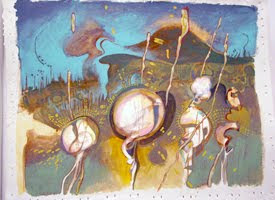Stealing Color: Formulas
Stealing Color, Paint Mixing Web Application now Available
Lately I have abandoned oil painting in lieu of this other method, which I find curious and preferable. The commercial production of colors, is heavily dependent on mathematics. Since I find some of the most interesting color relationships to be based on those that occur in the natural world, I began a process, which I call "stealing color". This means that i engage in a practice of taking digital photographs. I then modify the colors and export swatch palettes from those photographs, or modified photographs. Once I have the CMYK formulas for these colors, I run those numbers through an algorithm that I developed, and this gives me an equivalent for the color in tempera paints.
Tempera paints are formulated on CMYK. So, this process works fairly well. I also have a similar formula for commercial house paint. I use the tempera for small paintings and the commercial acrylic latex paint for larger works. These color formulations, eventually allow me to work more in the manner of drawing, with carefully selected colors. I have used this process for some recent social commentary works as well.
Using the printed color swatches, I can line up the swatches, pick the colors I am planning on using and mix up the exact color. There is minimal guesswork involved. This method gives a very good approximation and if done correctly, only slight modifications to the colors are needed.
Stealing Color: Mixing
Here is a sample of some colors that have been mixed using this method. I had to get some airtight containers. I previously had some plastic cups. I mixed about 80 colors, but they all dried. The paint didn't reconstitute well, and so I had to throw them out. You might be able to see a test paper to the left, used during the mixing process.
 Vacuous Fluff: Early Spring
Vacuous Fluff: Early Spring
These images might be preparatory for future giclee prints. At any rate, they are vacuous fluff images. I take this concept seriously. The term "vacuous fluff" is a hated concept in the arts, particularly in the west. But, unless we embrace vacuous fluff in our lives, we won't be able to handle it's counterpart; disjunctive mediation.
 Vacuous Fluff: 2012
Vacuous Fluff: 2012
I am not sure why I am anticipating calling this work 2012. There are references to Mayan and Aztec carvings at the bottom of the image. Also hidden among the patterns, is an image of a death mask, which has an umbilical cord coming out of the side, with a fetus attached. I don't know where it came from, but you could say that at the end, at the precipice of a paradigm shift, there is always continuity. I can't explain the form that looks like an over-easy egg with a red yolk.
a similar process used in other works
Incidentally, this is the same paint mixing process used in some disjunctive mediation works.




